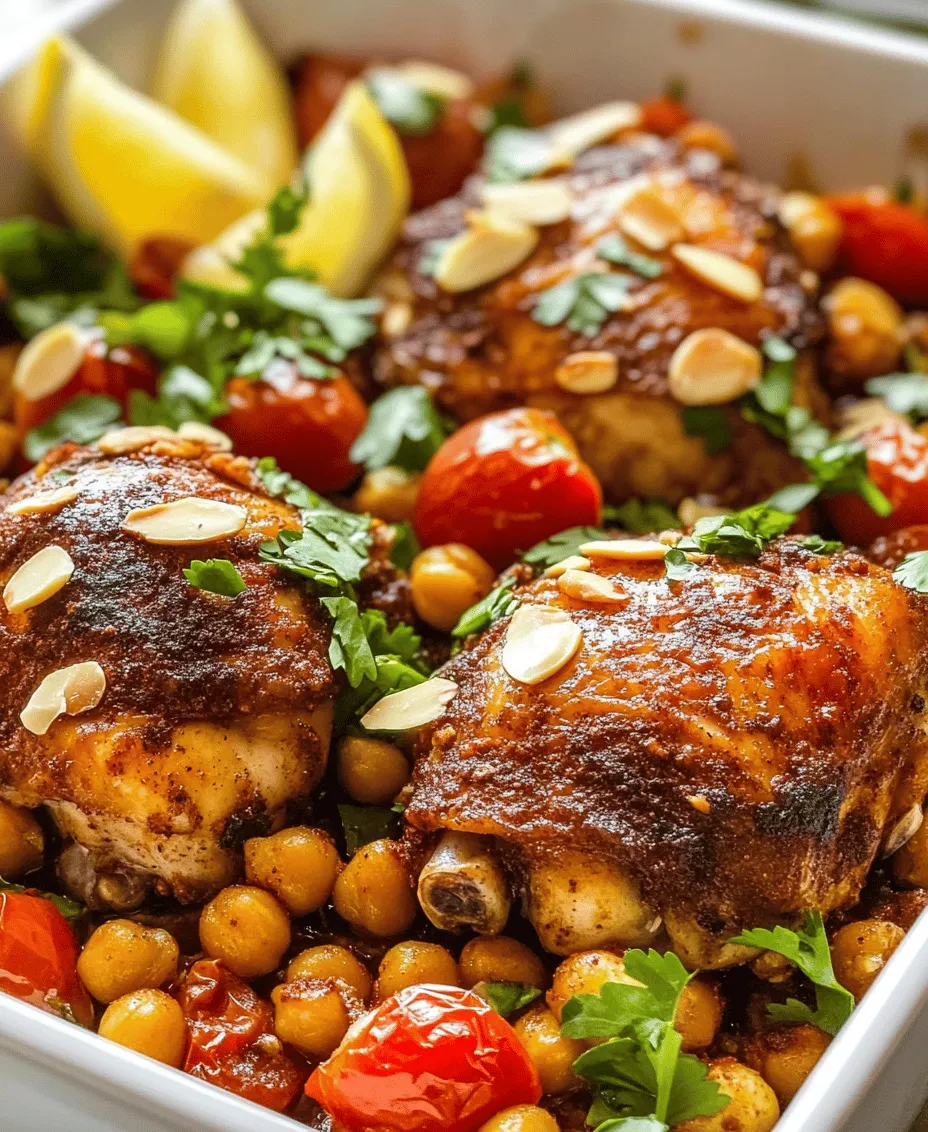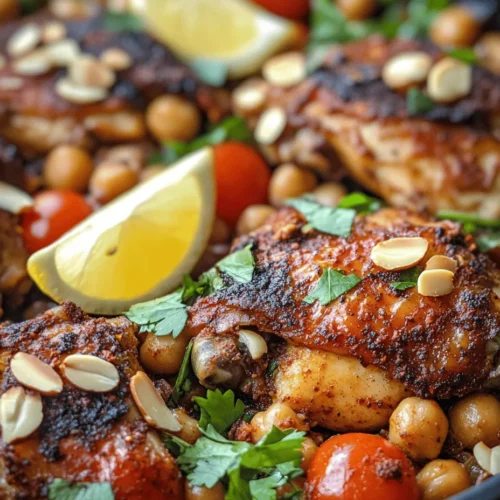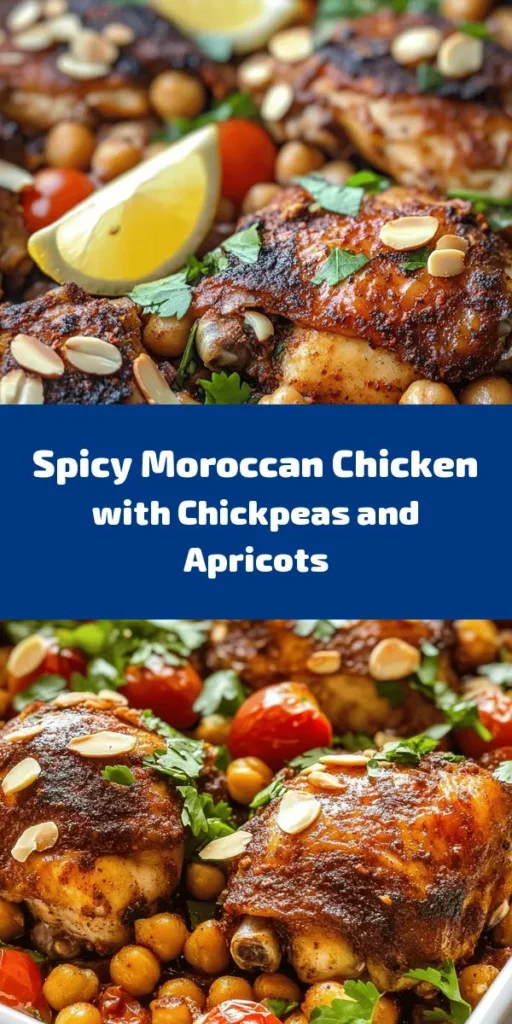Introduction
Moroccan cuisine is renowned for its vibrant flavors, aromatic spices, and rich history that reflects the cultural melting pot of North Africa. A delightful fusion of Berber, Arab, and Mediterranean influences, Moroccan food is celebrated for its ability to harmonize sweet and savory elements, creating a unique dining experience that tantalizes the taste buds. One dish that embodies these characteristics is Moroccan Spiced Chicken, a staple in Moroccan households and a crowd-pleaser at gatherings.
This recipe for Moroccan Spiced Chicken is not just a meal; it’s a sensory adventure. The dish showcases an exquisite blend of spices and fresh ingredients that come together to create a savory and aromatic feast. Characterized by the use of spices such as cumin, coriander, paprika, and cinnamon, the chicken is marinated to perfection, allowing the flavors to penetrate deeply into the meat. The result is a succulent, tender chicken that bursts with flavor, making it a perfect centerpiece for any occasion, from casual family dinners to festive celebrations.
The versatility of Moroccan Spiced Chicken allows it to shine in various culinary contexts. Whether served with fluffy couscous, hearty bread, or a refreshing salad, this dish adapts beautifully, bringing the essence of Moroccan hospitality into your home. As we delve deeper into the preparation of this dish, you will discover the secrets to its mesmerizing flavor profile and the cultural significance that underpins its popularity.
Exploring the Flavors of Moroccan Cuisine
At the heart of Moroccan cuisine lies a treasure trove of ingredients that contribute to its distinctive taste. From fresh herbs to sun-dried fruits, the variety of components used in Moroccan dishes creates a symphony of flavors that capture the essence of the region’s diverse culinary heritage. Key ingredients commonly found in Moroccan cooking include:
– Olive Oil: A staple in Mediterranean diets, olive oil is used for cooking and drizzling, imparting a rich flavor to dishes.
– Preserved Lemons: These add a unique tanginess and depth of flavor that is often associated with Moroccan tagines.
– Chickpeas: A common protein source, chickpeas are not only nutritious but also provide a satisfying texture to stews and salads.
– Dried Fruits: Ingredients like apricots and raisins add a touch of sweetness, balancing the savory notes in many dishes.
When it comes to spices, Moroccan cuisine is famed for its bold and aromatic profiles. The Moroccan Spiced Chicken recipe features a careful selection of spices that work in harmony to enhance the dish’s flavor:
– Cumin: Earthy and warm, cumin is a foundational spice in Moroccan cooking, adding depth to the flavor profile.
– Coriander: With its citrusy notes, coriander complements the richness of the chicken and enhances the overall freshness of the dish.
– Paprika: Often used for its vibrant color and mild heat, paprika adds a subtle sweetness that balances other spices.
– Cinnamon: A hallmark of Moroccan cuisine, cinnamon brings warmth and complexity, making it a perfect addition to savory dishes.
– Ginger: Fresh ginger adds a zesty kick, elevating the dish’s flavor and providing digestive benefits.
– Turmeric: Known for its golden hue and health benefits, turmeric imparts a slight earthiness and a wealth of antioxidants.
– Cayenne Pepper: For those who enjoy a bit of heat, cayenne pepper adds a spicy kick that elevates the overall experience.
The use of spices in Moroccan cooking exemplifies the culture’s emphasis on balance. The interplay between sweet and savory creates a dynamic flavor profile that is both satisfying and intriguing. This balance is particularly evident in Moroccan Spiced Chicken, where the spices dance with the natural flavors of the chicken, creating a dish that is sure to delight your palate.
Ingredients Breakdown for Moroccan Spiced Chicken
To create the perfect Moroccan Spiced Chicken, a carefully curated list of ingredients is essential. Each element plays a vital role in building the dish’s unique flavor and texture. Here’s a detailed breakdown of the ingredients you’ll need:
– Bone-in, Skin-on Chicken Thighs: The choice of chicken thighs is crucial for flavor and texture. The bone adds richness to the dish, while the skin helps retain moisture during cooking, resulting in tender, juicy meat. The thighs are also more forgiving than chicken breasts, making them ideal for slow cooking and marinating.
– Chickpeas: These legumes are a fantastic source of protein and fiber, making them a nutritious addition to the dish. When cooked, chickpeas become tender and absorb the aromatic flavors of the spices, adding substance and heartiness to the meal.
– Dried Apricots: Offering a sweet contrast to the savory spices, dried apricots enhance the complexity of the dish. They provide a chewy texture and a burst of natural sweetness that balances the spices beautifully. Additionally, they are rich in vitamins A and C, promoting overall health.
– Spices: As previously mentioned, the blend of cumin, coriander, paprika, cinnamon, ginger, turmeric, and cayenne pepper is what sets this dish apart. Each spice contributes its unique character, creating a harmonious balance of flavors that is quintessentially Moroccan.
– Olive Oil: Used for marinating and cooking, olive oil adds richness and depth to the dish. It also helps in the absorption of fat-soluble vitamins from the spices and chicken.
– Fresh Herbs: Fresh cilantro or parsley can be used as a garnish to brighten up the dish. These herbs not only add a burst of color but also enhance the overall flavor, making each bite refreshing.
Ingredient Substitutions and Variations
While the traditional ingredients provide the most authentic flavor, there are plenty of options for substitutions or variations. For those with dietary restrictions or preferences, consider the following:
– Chicken Breasts: If you prefer a leaner option, boneless, skinless chicken breasts can be used. However, be mindful that they may require less cooking time and can dry out more easily.
– Other Legumes: If chickpeas are unavailable, lentils or white beans can be excellent alternatives that still provide protein and texture.
– Fresh Fruits: If dried apricots are not to your liking, consider using raisins or dried figs for a different sweet element.
– Spice Adjustments: Customize the spice levels according to your taste. For a milder flavor, reduce the cayenne pepper or omit it altogether.
– Vegetarian Option: For a meatless version, substitute chicken with hearty vegetables like eggplant, zucchini, or cauliflower, and add more chickpeas to maintain protein content.
By understanding the role of each ingredient and being open to variations, you can make this Moroccan Spiced Chicken recipe uniquely yours while still honoring its traditional roots.
Marinating the Chicken: The Key to Flavor
Marination is one of the most critical steps in achieving the perfect Moroccan Spiced Chicken. This process not only infuses the chicken with the vibrant flavors of the spices but also enhances its tenderness, ensuring a succulent result. Here’s a step-by-step guide on how to marinate the chicken effectively:
1. Prepare the Marinade: In a large bowl, combine the olive oil, spices, and minced garlic. Whisk together until the mixture is well-blended and aromatic. The olive oil acts as a carrier for the spices, allowing them to penetrate the chicken more effectively.
2. Coat the Chicken: Add the chicken thighs to the bowl, ensuring each piece is thoroughly coated with the marinade. This step is crucial as it allows the flavors to adhere to the meat.
3. Marinating Time: Ideally, the chicken should be marinated for at least 2 hours, but overnight is best. This extended time allows the spices to deeply penetrate the meat, maximizing flavor. If you’re short on time, even a quick 30-minute marinade can impart some flavor, but it won’t reach the depth achieved with longer marination.
4. Refrigeration: Place the marinating chicken in the refrigerator. This is important not only for flavor infusion but also for food safety, as it keeps the chicken at a safe temperature.
5. Bring to Room Temperature: Before cooking, remove the chicken from the refrigerator about 30 minutes prior to cooking. Allowing it to come to room temperature ensures more even cooking and better texture.
Tips for Successful Marination
– Use Fresh Ingredients: Fresh spices and herbs will provide a more vibrant flavor compared to their dried counterparts. Always opt for the best quality you can find.
– Adjust Flavor Profiles: Don’t hesitate to tweak the marinade. For a tangier profile, add a splash of lemon juice or vinegar. For sweetness, a drizzle of honey can complement the spices beautifully.
– Avoid Over-Marinating: While marination is essential, be cautious not to exceed 24 hours, as the acid in the marinade can start to break down the meat fibers, leading to a mushy texture.
By mastering the art of marination, you set the stage for a Moroccan Spiced Chicken that is bursting with flavor and tenderness, ready to take center stage at your dining table.
Cooking Techniques for Optimal Results
Cooking Moroccan Spiced Chicken is as much about technique as it is about the ingredients. The method you use can significantly impact the final flavor and texture of the dish. Below are some essential cooking techniques that will help you achieve optimal results:
Browning the Chicken
One of the key techniques in preparing Moroccan Spiced Chicken is browning the chicken before cooking it through. This step is crucial for developing deeper flavors through the Maillard reaction, a chemical process that occurs when proteins and sugars in food undergo heat. Here’s how to do it effectively:
1. Heat the Skillet: Use a large skillet or Dutch oven and heat a generous amount of olive oil over medium-high heat. The oil should be hot enough to shimmer but not smoking.
2. Sear the Chicken: Carefully add the marinated chicken thighs, skin-side down, to the hot skillet. Allow the chicken to sear without moving it for about 5-7 minutes until a golden-brown crust forms. This crust not only enhances the flavor but also adds texture to the dish.
3. Flip and Brown: Once the skin is crispy and golden, flip the thighs over to brown the other side for another 5 minutes. This step helps lock in moisture and flavor.
4. Remove Excess Fat: After browning, remove the chicken from the skillet and set it aside. If there is excess fat in the pan, you can drain some of it while keeping the flavorful bits stuck to the bottom, which will add depth to your sauce.
Cooking in a Dutch Oven
For even cooking and to allow the flavors to meld beautifully, a Dutch oven is an excellent choice. Here’s how to utilize this versatile cookware:
1. Combine Ingredients: After browning the chicken, add any remaining marinade and additional ingredients like chickpeas and dried apricots to the Dutch oven.
2. Add Liquid: Pour in a bit of chicken broth or water to create steam, which helps cook the chicken through without drying it out.
3. Cover and Simmer: Place the lid on the Dutch oven and reduce the heat to low. Allow the chicken to simmer gently for approximately 30-40 minutes, depending on the size of the thighs. This slow cooking method ensures the meat becomes tender while absorbing the flavors of the spices and other ingredients.
4. Finishing Touches: Once the chicken is cooked through and tender, you can remove the lid and let it simmer uncovered for a few minutes to thicken the sauce if desired. This step intensifies the flavors and creates a luscious sauce to serve with the chicken.
By employing these cooking techniques, you can elevate your Moroccan Spiced Chicken to new heights, ensuring that every bite is filled with the essence of aromatic spices and succulent meat.
In the next part of this article, we will explore additional tips for serving, garnishing, and pairing the Moroccan Spiced Chicken with complementary side dishes. You’ll learn how to create a complete meal that embodies the warmth and hospitality of Moroccan culture. Stay tuned for more delectable insights into this amazing recipe!

Step-by-Step Guide on How to Sauté Aromatics Effectively
Sautéing aromatics is a critical step in creating the rich flavor base for your Moroccan Spiced Chicken. Begin by heating a generous amount of olive oil in a large skillet over medium heat. The oil should shimmer but not smoke, which indicates it is hot enough for sautéing.
1. Start with Onions: Add finely chopped onions first. The goal is to caramelize them, unlocking their natural sweetness. Stir occasionally, ensuring they don’t stick to the pan. Cook until they become translucent, about 5-7 minutes.
2. Add Aromatics: Once the onions are soft, introduce minced garlic and ginger. These ingredients will infuse the oil with their distinct flavors. Sauté for an additional 2-3 minutes, taking care not to burn the garlic, which can turn bitter.
3. Incorporate Spices: Sprinkle in your Moroccan spices, such as cumin, coriander, paprika, and cinnamon. Toasting the spices in the oil for about a minute will enhance their aroma and flavor. This step is crucial as it lays the foundation for the entire dish.
4. Balance the Flavors: After the spices are fragrant, add chopped tomatoes to create a base sauce. Stir well and let everything cook together for a couple of minutes. This will help meld the flavors before you add the chicken.
Bringing It All Together: Combining Ingredients
Now that your aromatics are perfectly sautéed, it’s time to bring everything together.
1. Combine the Chicken: Add the marinated chicken pieces to the skillet. Make sure to coat each piece thoroughly in the aromatic mixture. This is where the magic happens; the chicken will absorb all those beautiful flavors.
2. Layering Flavors: As you combine the chicken with the sautéed aromatics, remember that layering flavors is essential. Each ingredient contributes to the overall taste. The spices will infuse the chicken, while the onions, garlic, and ginger provide depth.
3. Add Chickpeas and Broth: After the chicken is well combined, toss in canned chickpeas (drained and rinsed) and pour in chicken broth. This will create a lovely sauce and ensure that the chicken stays moist during cooking.
Simmering to Perfection: The Cooking Process
Simmering is a gentle cooking technique that allows flavors to meld beautifully.
1. Understanding Simmering: After combining all the ingredients, bring the mixture to a gentle boil. Once boiling, reduce the heat to low and cover the pan with a lid. This will allow the chicken to cook evenly while keeping it tender.
2. Covering the Pan: Covering the pan is vital for moisture retention. This helps to create a steamy environment, which cooks the chicken thoroughly without drying it out. Allow the chicken to simmer for about 30-35 minutes, stirring occasionally.
3. Checking Doneness: To ensure the chicken is perfectly cooked, check its internal temperature with a meat thermometer. The thickest part of the chicken should reach 165°F (75°C). If you don’t have a thermometer, make a small cut in the chicken; it should be opaque and the juices should run clear.
4. Achieving Tender Meat: Tender chicken is the goal. Simmering allows the connective tissues to break down, making the meat juicy and flavorful. If the sauce appears too thick, you can add a splash more of the chicken broth to reach your desired consistency.
Garnishing and Serving Suggestions
The final presentation of your Moroccan Spiced Chicken can elevate the dish even further.
1. Garnishing: Just before serving, sprinkle slivered almonds and freshly chopped herbs like cilantro or parsley over the chicken. These not only add a beautiful contrast in color but also enhance the dish’s flavor profile.
2. Side Dishes: Moroccan Spiced Chicken pairs beautifully with various sides. Serve it with fluffy couscous to soak up the delicious sauce, or warm pita bread for a delightful experience. A fresh salad with a citrus vinaigrette can also balance the richness of the dish.
3. Serving with Lemon Wedges: Do not forget to serve lemon wedges on the side. A squeeze of fresh lemon juice right before eating brightens the flavors and adds a refreshing zing, making each bite even more enjoyable.
Nutritional Information and Health Benefits
Understanding the nutritional profile of Moroccan Spiced Chicken can help you appreciate its health benefits.
– Per Serving Breakdown: One serving of Moroccan Spiced Chicken (about 1 cup) typically contains approximately 350 calories, 30 grams of protein, 15 grams of carbohydrates, and 20 grams of fat. The chickpeas add additional fiber and protein, making it a well-rounded meal.
– Health Benefits: The primary ingredient, chicken, is a great source of lean protein, essential for muscle repair and growth. Chickpeas are high in fiber, which supports digestive health and can aid in weight management.
– Role of Spices: The spices used in this recipe, such as turmeric and cumin, are known for their anti-inflammatory properties and potential health benefits. Spices not only enhance flavor but also contribute to overall wellness.
Conclusion
The journey of flavors in Moroccan Spiced Chicken is a celebration of culinary traditions and rich ingredients. From the aromatic beginnings to the final garnishing touches, each step enhances the dish’s complexity and appeal. This recipe is versatile, making it a fantastic choice for family dinners, festive gatherings, or special occasions where you want to impress your guests.
As you explore the richness of Moroccan cuisine, don’t hesitate to try making this delightful dish. It’s a wonderful opportunity to bring the warmth and comfort of Moroccan flavors to your table. Enjoy the cooking process, savor the delicious results, and share your culinary creation with friends and family.



